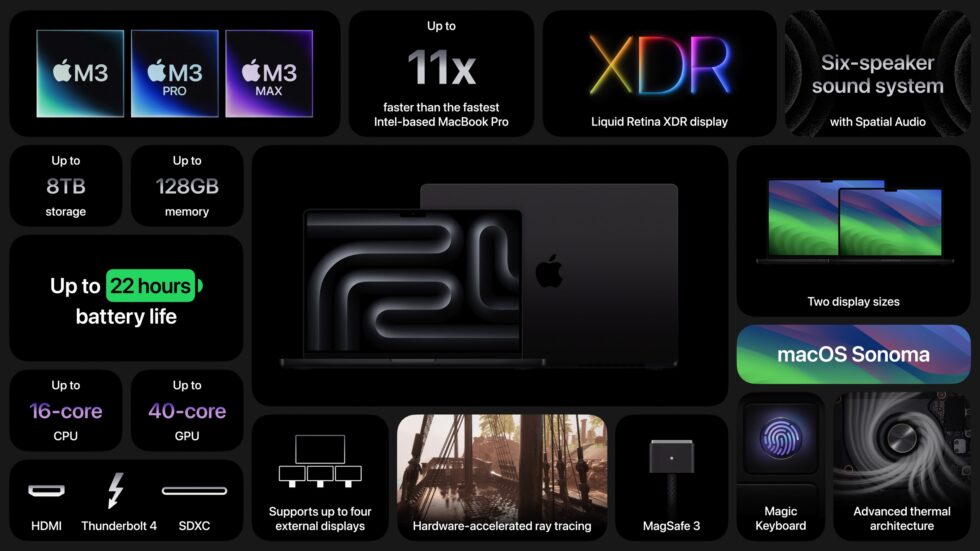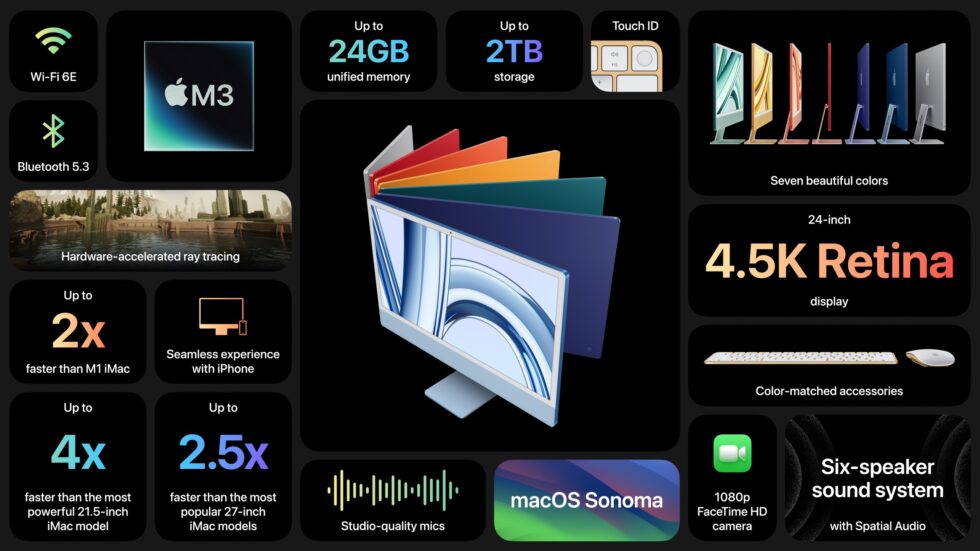Last month, Apple unveiled its next-generation Apple silicon chips for Macs: the M3, M3 Pro, and M3 Max. Based on these chips, Apple also showcased new 14-inch and 16-inch MacBook Pro models and a faster version of the 24-inch iMac (and dropped its 13-inch MacBook Pro model).
Besides the new chips, all of the updated MacBook Pro models boast brighter screens. The M3 14-inch model also has a slightly longer battery life, and there is a new Space Black aluminum finish for the M3 Pro and M3 Max models.
Power from the M3 Chip Family for the 14-inch and 16-inch MacBook Pros
While the MacBook Air has done an admirable job of supporting everyday laptop users, professionals who rely on processor-intensive apps have long turned to the 14-inch and 16-inch MacBook Pro for more power. Apple did update the MacBook Pro to the M2 Pro and M2 Max in January 2023. There’s less reason to upgrade from an M2 model to a new M3 model—but when upgrading from Intel-based and M1 models, the performance gains are significant.
For instance, the M3 MacBook Pro models beat the equivalent Intel-based MacBook Pro models by 3x, 5.5x, 7.4x, and even 20x, depending on the specific app and task; overall, Apple claims speed improvements up to 11x over the fastest Intel-based MacBook Pro models. And gains over equivalent M1-based MacBook Pros are significant, from 30-60% improved.
Available Configurations for the 14-inch and 16-inch MacBook Pros
Apple expanded the options for the 14-inch MacBook Pro to offer three basic configurations:
- M3 starting at $1599: This model has an 8-core CPU, a 10-core GPU, 8GB of memory, and 512GB of storage. You can (and probably should) jump to 16GB, or even 24GB, of memory. The M3 has two Thunderbolt/USB 4 ports and can drive a single external display.
- M3 Pro starting at $1999: This model has either 11 or 12 CPU cores; 14 or 18 GPU cores; and 18GB or 36GB of memory. The M3 Pro has three Thunderbolt/USB 4 ports and supports one or two external displays.
- M3 Max starting at $3199: This maxed-out configuration has either 14 or 16 CPU cores; 30 or 40 GPU cores; and 36GB or 96GB of memory. The M3 Max has three Thunderbolt/USB 4 ports and supports up to four external displays.
The 16-inch MacBook Pro offers two configurations:
- M3 Pro starting at $2899: This model has a 12-core CPU, an 18-core GPU, and 36GB of memory.
- M3 Max starting at $3499: This model has either 14 or 16 CPU cores and 30 or 40 GPU cores. The various configurations available allow for 36GB, 48GB, 64GB, 96GB, or 128GB of memory.
Storage starts at 512GB for the M3 14-inch model and at 1TB for the rest, with options for 2TB, 4TB, and 8TB.
The M3 14-inch MacBook Pro replaces the M2 13-inch MacBook Pro, which offered only the slightest advantage over its cheaper M2 13-inch MacBook Air cousin. The $100 price increase for the new M3 14-inch MacBook Pro over the old 13-inch MacBook Pro is a fair trade; the former has a bigger, better screen and a 1080p FaceTime HD camera. Other prices have also increased, but mostly because the new configurations include more unified memory. For example, the M3 Pro 16-inch MacBook Pro previously started at $2499 with 16GB of memory, but now starts at $2899 with 36GB of memory.
M3 Chip Improves 24-inch iMac Performance
The refreshed 24-inch iMac remains an attractive option for those looking for an all-in-one desktop Mac. It keeps its $1299 starting price, but trades its M1 chip for an M3, which provides more memory choices. Previous options were 8GB or 16GB; with the M3, the standard is 8GB, and upgrades are available for 16GB (a good idea) and 24GB (likely unnecessary for most people). Storage still starts at 256GB, with available upgrades to 512GB, 1TB, or 2TB.


